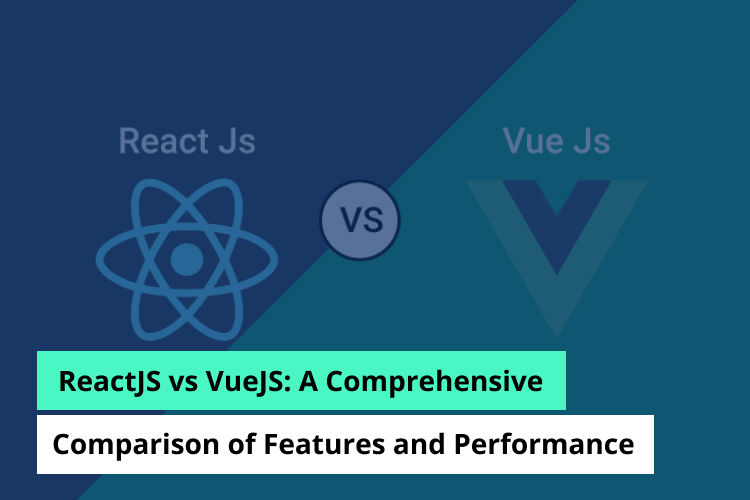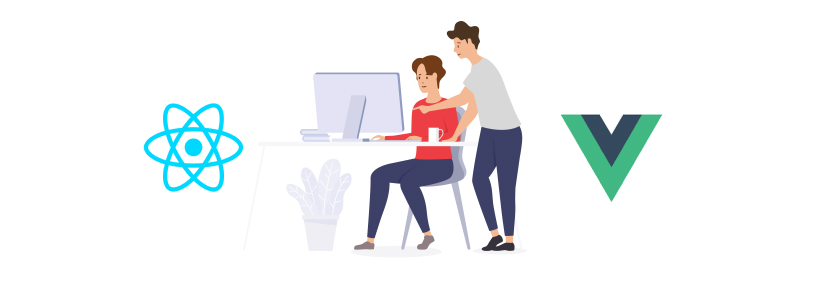ReactJS vs VueJS: A Comprehensive Comparison of Features and Performance

Both the ReactJS and VueJS JavaScript frameworks are widely used to create modern web applications. These frameworks have been used by a number of big-name companies and organizations to develop high-quality and efficient web applications.
For example, Facebook’s web app is built using ReactJS, and the company has contributed significantly to the development and maintenance of the ReactJS ecosystem. Airbnb also uses ReactJS for its web application, which helps millions of users book unique accommodations around the world.
On the other hand, VueJS has been used by companies like Xiaomi, Alibaba, and Baidu to build large-scale web applications that are both efficient and easy to maintain. The VueJS framework is also used by a number of startups and small businesses due to its ease of use and simple syntax.
Overall, both ReactJS and VueJS have been widely adopted in the industry and have proven to be effective tools for building modern web applications. In this blog, we will compare the features and performance of these two frameworks and discuss factors to consider when choosing between them.
Let’s start with exploring the details and comparison of ReactJS and VueJS:
Explanation of ReactJS and VueJS:
ReactJS is a JavaScript library created by Facebook that focuses on creating user interfaces using a component-based design. React is quick and effective because it renders components using a virtual DOM (Document Object Model). React also offers a wide range of tools and libraries, such as Redux and React Native, that can be used to extend its functionality and build mobile applications.
VueJS, created by Evan You, is a JavaScript framework that is also focused on building user interfaces using a component-based architecture. Vue uses a virtual DOM similar to React, but it also has a template-based syntax that makes it easy to understand and use. Vue has a wide range of capabilities that may be used to create complicated applications, such as Vuex for state management and Vue Router for routing.
Both ReactJS and VueJS offer distinctive qualities and benefits, and which one is best will ultimately depend on the particular requirements of a project.
Importance of Choosing the Right Framework for a Project:
Choosing the right framework for a project is crucial because it can have a significant impact on the success of the project. The framework choice can affect many aspects of the project, such as the development process, user experience, scalability, maintainability, and performance.
Using the wrong framework can lead to many problems, such as slower development time, poor performance, difficult maintenance, and low user satisfaction. On the other hand, choosing the right framework can lead to faster development time, better performance, easier maintenance, and higher user satisfaction.
The right framework should fit the project’s specific needs and goals. For example, if the project requires building complex user interfaces, a framework that emphasizes component-based architecture and provides tools for state management and routing might be a better choice. If the project requires building a mobile application, a framework that supports mobile development, such as React Native, might be a better choice.
Features Comparison of ReactJS and VueJS:

ReactJS and VueJS share many similarities in terms of their features, such as their component-based architecture and the use of virtual DOM. However, they also have their unique features and advantages, such as ReactJS’s vast ecosystem of tools and libraries and VueJS’s easy-to-use template syntax. The particular requirements and objectives of the project will eventually determine which option is best.
ReactJS:
A well-liked JavaScript library for creating user interfaces is ReactJS. It stands apart from other frameworks thanks to a number of its characteristics. Some of the key features of ReactJS are:
- Component-based architecture: Built on a component-based design, ReactJS was created. To design sophisticated user interfaces, components may be combined and reused as building blocks. Components can be nested inside of other components and can be declared as functions or classes. This approach makes it easier to manage and update the user interface.
- Virtual DOM: A virtual DOM (Document Object Model) that ReactJS employs is a simplified version of the real DOM. React updates just the portions of the user interface that have changed thanks to the virtual DOM, which makes it quick and effective. React evaluates the difference between the old and new states when a component’s state changes and updates the virtual DOM appropriately. Reconciliation is the name given to this procedure.
- Tools and libraries: A huge ecosystem of tools and frameworks exists for ReactJS that may be utilized to increase its capability. Redux for state management, React Router for routing and React Native for developing mobile applications are some of the well-liked tools and technologies.
VueJS:
A JavaScript framework for creating user interfaces is called VueJS. It is a popular option among developers because of a number of distinctive characteristics. A few of VueJS’s standout characteristics are:
- Component-based architecture: ReactJS and VueJS both have a component-based design as their foundation. To design sophisticated user interfaces, components may be combined and reused as building blocks. Components can be defined as templates or single-file components, and they can be nested inside other components.
- Virtual DOM: A virtual DOM is used by VueJS and ReactJS to refresh the user interface. As the state of a component changes, VueJS analyses the difference between the old and new states and updates the virtual DOM accordingly. VueJS is quick and effective because of this method.
- Template-based syntax: Because of its template-based syntax, VueJS is simple to comprehend and utilize. The template syntax is similar to HTML, which makes it easier for developers who are familiar with HTML to get started with VueJS.
- Features: Building complicated user interfaces is made simpler by a number of built-in capabilities in VueJS. For example, Vuex is a state management library that can be used to manage the application’s state, and Vue Router is a routing library that can be used to handle navigation between pages.
Performance Comparison of ReactJS and VueJS:
Both ReactJS and VueJS are known for their fast performance, and they have several tools and techniques that can be used to optimize performance. ReactJS uses a virtual DOM to update the user interface, while VueJS uses a reactive system. Both strategies have benefits and drawbacks, and which one is best for a given project will ultimately rely on its particular requirements and objectives.
ReactJS:
ReactJS is known for its fast performance, which is due to several factors. Some of the key performance features of ReactJS are:
- Virtual DOM: ReactJS uses a virtual DOM (Document Object Model) to update the user interface. ReactJS updates just the parts of the user interface that have changed as a result of the virtual DOM, making it faster and more effective. As a component’s state changes, React examines the difference between the old and new states and updates the virtual DOM accordingly.
- Tools for performance optimization: ReactJS has several tools and techniques that can be used to optimize performance. For example, React.memo can be used to memorize components and avoid unnecessary re-renders. React.lazy can be used to lazy-load components and improve the initial loading time.
VueJS:
VueJS is also known for its fast performance. Some of the key performance features of VueJS are:
- Reactive system: As the data changes, VueJS’s reactive architecture instantly adjusts the user interface. VueJS is quick and effective thanks to this method because it does away with manual upgrades.
- Tools for performance optimization: Performance may be improved with the help of a number of VueJS tools and methods. For example, computed properties can be used to cache the results of expensive computations and avoid unnecessary re-computations. Watchers can be used to watch for changes in the data and trigger updates when necessary.
Ease of Use Comparison of ReactJS and VueJS: 
Both ReactJS and VueJS have their strengths and weaknesses when it comes to ease of use. ReactJS has a steeper learning curve and requires developers to learn additional tools, while VueJS has a simpler syntax and a gradual learning curve. The choice between the two will ultimately depend on the specific needs and goals of the project.
ReactJS:
ReactJS has a reputation for having a steep learning curve, which can make it challenging for beginners to get started. Some of the factors that contribute to this include
- JSX syntax: ReactJS uses JSX syntax, which is a combination of HTML and JavaScript. This syntax can be confusing for developers who are not familiar with it.
- Need to learn additional tools: A huge ecosystem of tools and frameworks exists for ReactJS that may be utilized to increase its capability. Developers must, however, get familiar with and incorporate these technologies into their projects. For instance, React Native is a well-liked tool for creating mobile applications, and Redux is a well-known state management toolkit that is frequently used with ReactJS.
VueJS:
VueJS, on the other hand, has a reputation for being easier to learn and use than ReactJS. Some of the factors that contribute to this include:
- Simple syntax: VueJS uses a simple and easy-to-understand syntax that is similar to HTML. This makes it easier for developers unfamiliar with JavaScript or JSX syntax to get started with VueJS.
- Gradual learning curve: VueJS has a gradual learning curve, which means that developers can start using it with just the basics and gradually learn more advanced features as needed.
The performance and scalability of VueJS are one of its drawbacks, though. Although it is simple to use and pick up, it might not be the greatest option for demanding high-performance big and complicated applications.
Community and Ecosystem Comparison of ReactJS and VueJS:
ReactJS and VueJS have active communities and ecosystems that provide a wealth of resources and support for developers. ReactJS has a larger and more established ecosystem, with tools like React Native for building mobile applications. VueJS, on the other hand, is growing rapidly and has a reputation for being easy to use and learn. The choice between the two will ultimately depend on the specific needs and goals of the project.
ReactJS:
There is a sizable and vibrant developer and user community for ReactJS. One of ReactJS’s biggest benefits is the community, which offers a plethora of tools and assistance for developers. The following are some significant aspects of the ReactJS ecosystem and community:
- Large and active community: There is a large and vibrant community of users and developers that work on and support the ReactJS technology. This community offers a multitude of materials, such as guides, libraries, and documentation.
- Strong ecosystem: A robust ecosystem of tools and frameworks exists for ReactJS that may be leveraged to increase its capability. Redux for state management, React Router for routing and React Native for developing mobile applications are some of the well-liked tools and technologies.
VueJS:
VueJS also has an active community, although it is not as large as the ReactJS community. However, the VueJS community is growing rapidly, and it provides a wealth of resources and support for developers. Some of the key features of the VueJS community and ecosystem include:
- Active community: The VueJS community is growing rapidly, and it is becoming more active with each passing day. This community offers a multitude of materials, such as guides, libraries, and documentation.
- Growing ecosystem: The VueJS ecosystem is still relatively small compared to ReactJS, but it is growing rapidly. There are many tools and libraries available for VueJS, including Vuex for state management and Vue Router for routing.
Factors to Consider When Choosing between ReactJS and VueJS:
Choosing between ReactJS and VueJS depends on several factors, including project requirements, developer expertise, learning curve, community and ecosystem, scalability and performance, and cost. You can make a well-informed selection and select the ideal framework for your project by carefully weighing these considerations.
Many variables must be taken into account while deciding between ReactJS and VueJS for a project. The following are some important things to bear in mind:
- Project requirements: The first and most crucial factor to consider is the specific requirements of the project. The size, complexity, and performance needs of the project should all be taken into account, as should any interconnections with other technologies or platforms.
- Developer expertise: Consider the expertise and experience of your development team. If your team has experience with one framework over the other, it may be easier and more efficient to choose that framework.
- Learning curve: ReactJS has a steeper learning curve than VueJS, which may be a consideration if you have a limited timeline or if your development team is new to the framework.
- Community and ecosystem: For each framework, consider the scope and activity of the community and ecosystem. For developers, a robust community and ecosystem may offer helpful information, assistance, and tools.
- Scalability and performance: Consider the scalability and performance of each framework. ReactJS is known for its performance optimization tools and virtual DOM, while VueJS has a reputation for being easy to use but may have limitations in scalability and performance.
- Cost: Consider the cost of using each framework. ReactJS and VueJS are both open-source and free to use, but there may be additional costs associated with using specific tools or libraries.
Conclusion:
ReactJS and VueJS are popular and powerful frameworks for building web applications. ReactJS is known for its performance optimization tools and extensive ecosystem, while VueJS is popular for its ease of use and simplicity. When choosing between ReactJS and VueJS, it’s important to consider factors such as project requirements, developer expertise, learning curve, community and ecosystem, scalability and performance, and cost. By carefully evaluating these factors, developers can make an informed decision and choose the best framework for their specific project needs. In the end, both ReactJS and VueJS are excellent choices for developing contemporary online apps, and which one to use will depend on the particular needs and objectives of the project.
Similar Posts

Exploring the Power of PHP: Use Cases and Best Practices
Are you a developer seeking a powerful and versatile solution for your web development projects? Have you been pondering over the perfect language to breathe life into your innovative ideas and turn them into reality? Look no further, as we present to you the answer to your web development quest: PHP – a dynamic scripting […]...

ReactJS vs Angular choosing the right framework for your next web app
If you looking to build your website or web application with the latest modern web development frameworks, you might be wondering whether you should go for ReactJS or Angular. Well, this blog will save time and help you decide which framework is best for your next app. Stay along! A framework may make all the […]...

Can Laravel be used for building Enterprise Apps?
Can Laravel be used for building Enterprise Apps?Laravel has emerged as one of the most popular PHP frameworks for building enterprise apps. There are several reasons that contribute to the popularity of the Laravel framework for enterprise apps. Many of the large businesses found Laravel suitable for building their enterprise apps....







